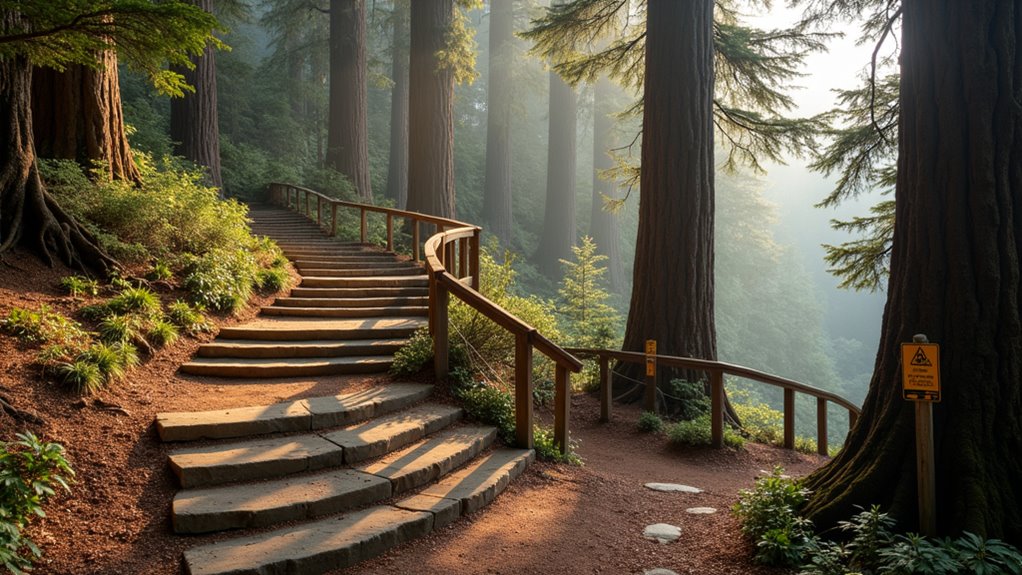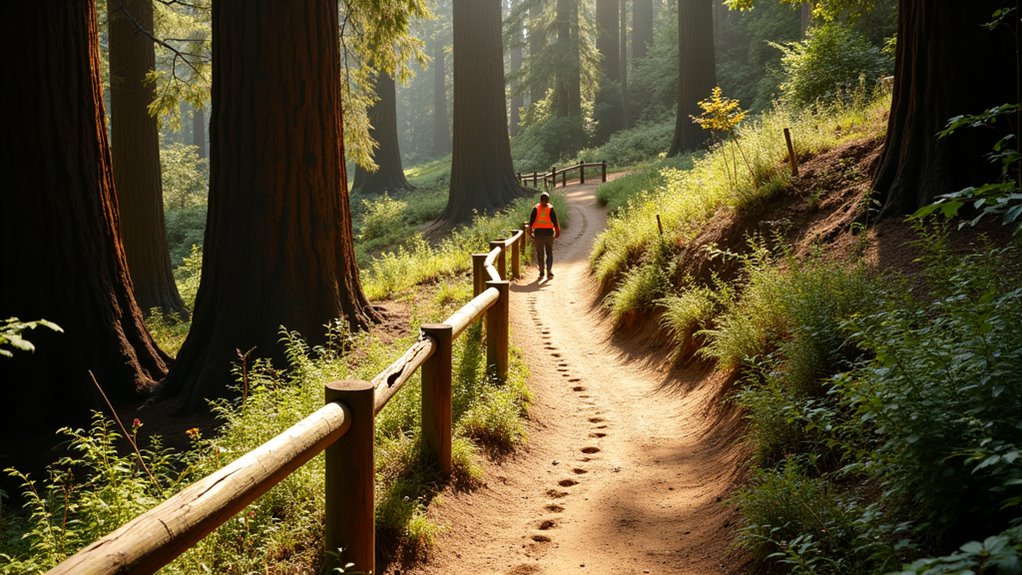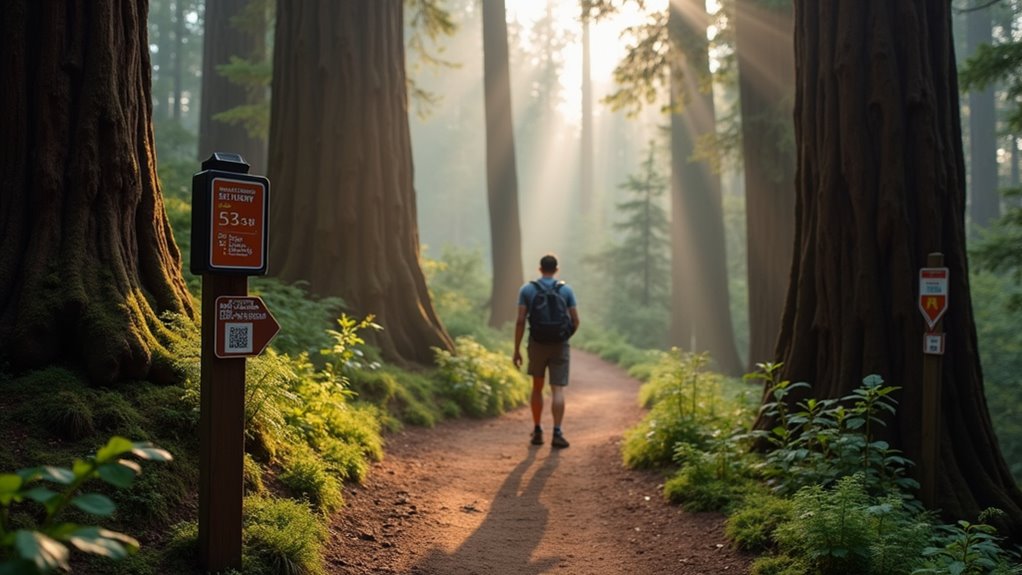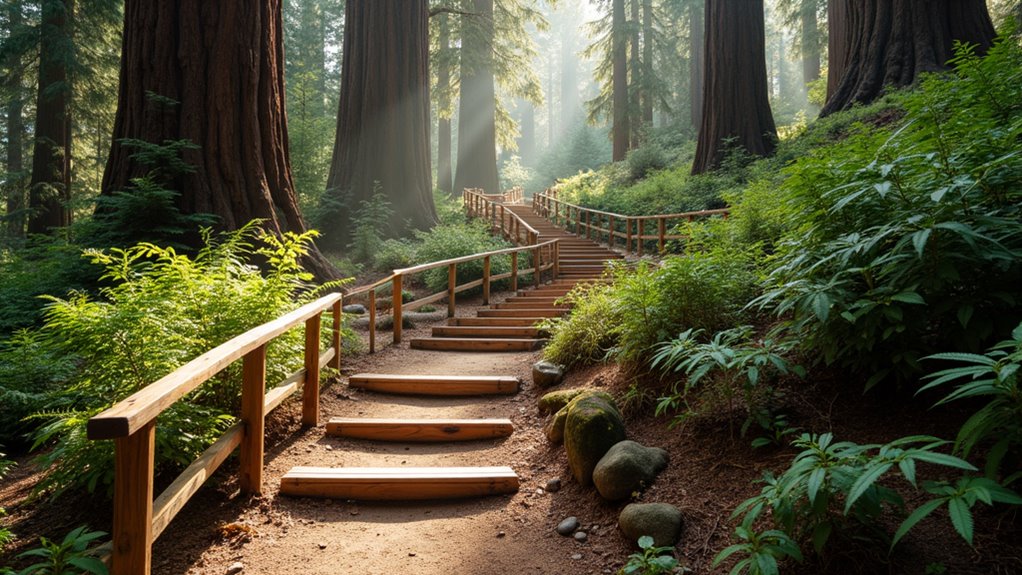Physical Address
304 North Cardinal St.
Dorchester Center, MA 02124
Physical Address
304 North Cardinal St.
Dorchester Center, MA 02124

Outdoor enthusiasts discover why California's meticulously designed trails make wilderness adventures both thrilling and remarkably secure.
While California’s rugged wilderness can seem intimidating, you’ll find its hiking trails are masterfully designed for your safety and enjoyment. You’re never far from essential amenities like emergency call boxes, clear directional markers, and well-maintained rest areas on these paths. Whether you’re a novice walker or seasoned trekker, these trails offer the perfect blend of adventure and security. Let’s explore how California’s trail systems can transform your outdoor experience from uncertain to unforgettable.

While California’s diverse terrain presents unique hiking challenges, its trail systems feature extensive safety measures designed to protect outdoor enthusiasts.
You’ll find informational signs at trailheads warning about difficulty levels, weather conditions, and wildlife presence. USGS topographical maps are available for free at many trailheads to help with navigation. On steep sections, you’ll notice guardrails, anti-slip surfaces, and reinforced steps to prevent accidents, especially in rocky areas above 1800m where terrain becomes more challenging.
For your safety, rest areas and benches are strategically placed along trails, and emergency call boxes provide quick access to help when needed. Plus, first aid stations are situated at regular intervals to assist hikers in case of emergencies.
You can rely on clear distance markers and directional arrows to stay on course, while visible identification markers assist rescue teams in locating you during emergencies.
Remember to check trail closure notices and weather advisories before heading out on your adventure.
Since California’s vast network of trails demands reliable navigation, you’ll find an array of modern tools and traditional markers to guide your journey. Digital platforms like Gaia GPS and CalTopo put powerful mapping capabilities at your fingertips, while traditional blaze markings and signage serve as reliable physical waypoints. Most basic features of these apps are available for free, allowing hikers to start navigating confidently without initial investment.
You’ll master trail navigation by understanding these essential components:
Essential camping gear can help ensure your outdoor adventures are safe and comfortable.
Whether you’re exploring urban pathways or backcountry routes, you can confidently navigate California’s 48,950 miles of non-motorized trails using both digital tools and physical markers.

California’s diverse wilderness brings you face-to-face with an extraordinary array of wildlife along its trails, from majestic black bears to elusive mountain lions.
While encounters with larger predators are rare, you should be prepared, especially on popular routes like the PCT south of the High Sierra. Your safety depends on proper wildlife management practices.
Stay alert and prepared when hiking California’s backcountry trails – wildlife encounters, though uncommon, require proper safety measures.
Always carry a bear canister to store food and avoid attracting bears to your campsite. Don’t get between a mother bear and her cubs, and be ready to use hazing techniques like shouting if needed. Modern hikers face far fewer encounters than early pioneers who documented seeing diverse herbivore populations including antelope, elk, mule deer, and moose along the trails. Essential safety gear should be carried for your next camping adventure.
Though wildlife-related fatalities are extremely low in California’s parks, you should maintain situational awareness.
Stay on marked trails, follow Leave No Trace principles, and check current wildlife alerts before heading out. These practices help protect both you and the local wildlife.
Selecting the right hiking trail isn’t just about protecting yourself from wildlife – it’s about matching your abilities to the challenge ahead.
You’ll find California’s trails rated from easy Class 1 walks to demanding Class 4 climbs, each requiring different fitness levels and technical skills.
To choose a trail that matches your capabilities, consider these critical factors:
Don’t underestimate trail difficulty – it’s better to start conservative and work your way up as you gain experience and confidence. Plus, it’s important to be aware of thunderstorm safety when planning your hiking trip.

While traditional paper maps still have their place, modern technology has revolutionized how you’ll experience California’s hiking trails. You’ll find GPS-enabled apps that provide real-time tracking, detailed elevation profiles, and offline accessibility when you’re out of cell range.
Interactive digital maps help you plan your route and monitor your progress with unprecedented accuracy. The maps offer exclusive trail data unavailable in most other digital or paper formats. For added safety, you’ll benefit from emergency alert systems and weather updates right on your mobile device.
Digital mapping tools revolutionize trail navigation, offering precise tracking and real-time safety features for today’s tech-savvy hikers.
Many trails now feature QR codes at key points, connecting you to educational content about local flora, fauna, and history. You can even participate in citizen science projects through data collection apps. Essential tips for camping off the grid can further enhance your hiking experience.
With digital kiosks at trailheads and virtual ranger assistance, you’ll have access to crucial information and support throughout your hiking adventure.
Environmental protection stands at the forefront of California’s trail management, with extensive measures guaranteeing you’ll minimize your impact while hiking.
You’ll find hardened trail treads, strategic water management features, and carefully planned routes that protect native vegetation while keeping you safe on your journey.
To protect California’s delicate ecosystems, follow these essential practices:
You’ll notice educational signage and ongoing trail maintenance that help preserve the natural environment. Non-motorized trail use is considered passive recreation and aligns with conservation goals.
Trail managers regularly monitor conditions, remove invasive species, and implement adaptive strategies to guarantee sustainable hiking experiences while safeguarding California’s precious ecosystems.

Modern California trails embrace innovative accessibility designs that welcome hikers of all abilities and mobility levels.
You’ll find thoughtfully engineered paths with firm, stable surfaces that accommodate wheelchairs and mobility aids. Trail grades are carefully minimized to prevent challenging slopes, while wider pathways allow easy passing and maneuvering. Many trails like the Founders Grove Loop provide half mile loops perfect for shorter, manageable hikes.
When you visit California’s accessible trails, you’ll notice strategically placed trailheads equipped with ADA-compliant amenities, including parking and restrooms. Respectful camping is crucial to maintaining the harmony of these outdoor spaces.
Trail signage includes tactile and braille elements for visually impaired visitors. On multiuse paths, you’ll see design features that safely separate different user groups, from hikers to cyclists.
These accessible trails aren’t just about meeting regulations – they’re about creating inclusive outdoor experiences where everyone can enjoy California’s natural beauty safely and comfortably.
As California’s diverse landscapes shift through distinct seasons, you’ll need to adapt your hiking plans to match the varying trail conditions throughout the year.
Summer offers ideal hiking with dry trails and warm temperatures, while spring presents a mix of snow-covered high elevations and blooming lower trails. Early June through July can be challenging due to fast-moving creeks and melting snow.
For a safe and enjoyable hike, remember these essential preparation steps:
During the rainy season, you’ll find many trails become slick and muddy, particularly in redwood forests. To ensure a cozy sleep while winter camping, pack warm layers and insulating equipment.
Always prioritize safety by hiking in groups and staying alert to changing weather conditions.

Maintaining California’s extensive network of hiking trails requires year-round dedication from trail crews and volunteers who tackle everything from basic debris removal to complex infrastructure repairs.
You’ll find these hardworking teams focusing on critical tasks like repairing water bars, stabilizing retaining walls, and managing erosion control. They’ll time their work when soil moisture is ideal for lasting repairs, ensuring trails remain safe and accessible. Trail Gorillas and other dedicated groups work tirelessly in places like the San Gabriel Mountains to implement crucial erosion mitigation measures.
Local materials, such as granite, are used to rebuild damaged sections while preserving the natural environment.
When you’re hiking, you’re benefiting from carefully planned maintenance schedules that prioritize high-impact areas. Trail crews inventory bridges, steps, and other features to predict repair needs and allocate resources efficiently. Camping disasters can be avoided on these well-maintained trails.
You’ll discover that California’s hiking trails aren’t just pathways; they’re meticulously crafted experiences designed with your safety in mind. With over 70% of trails featuring advanced GPS markers and emergency systems, you’re never truly alone on your adventure. Remember to leverage these robust safety features, respect nature’s boundaries, and embrace the technology that’s revolutionizing trail navigation. Your next safe hiking experience awaits on California’s world-class trails!